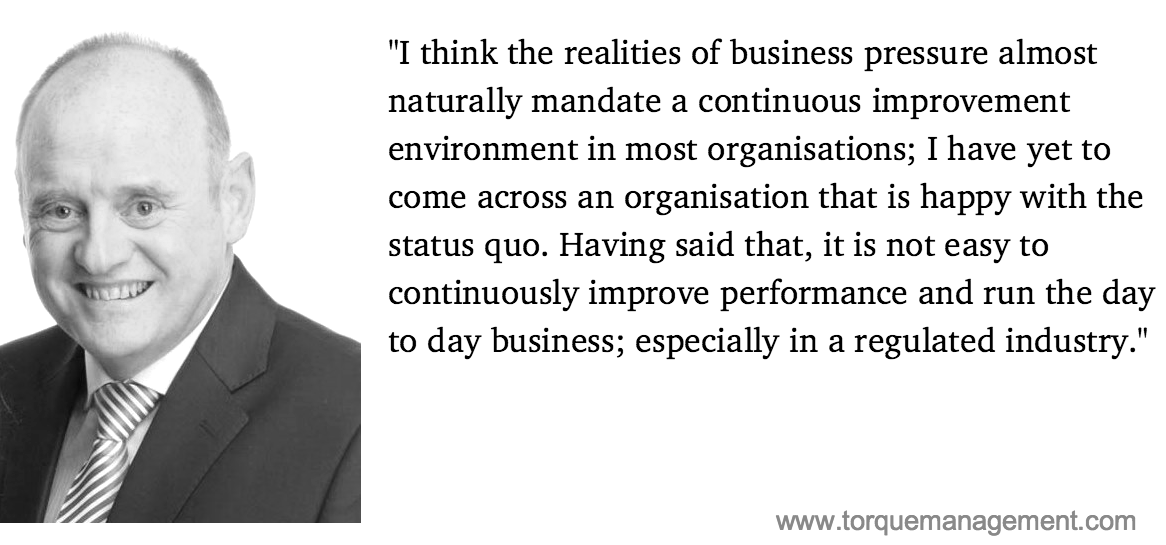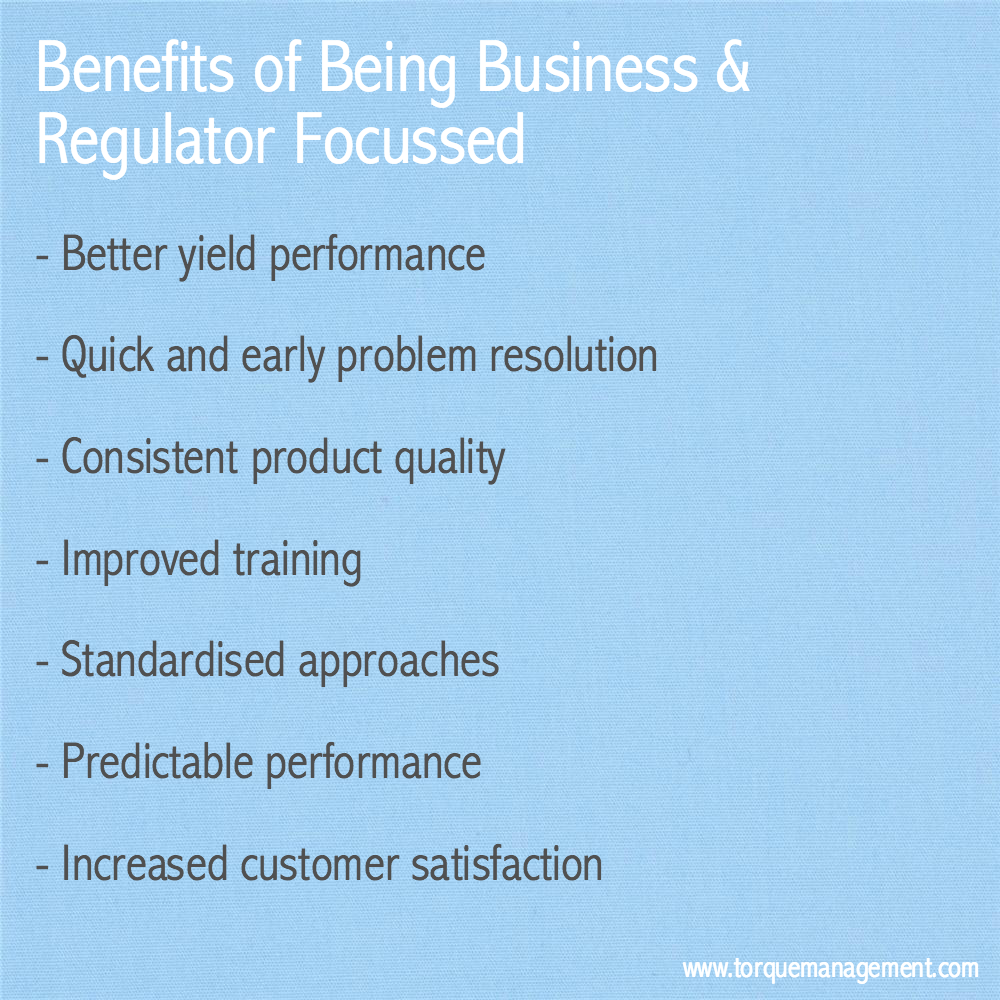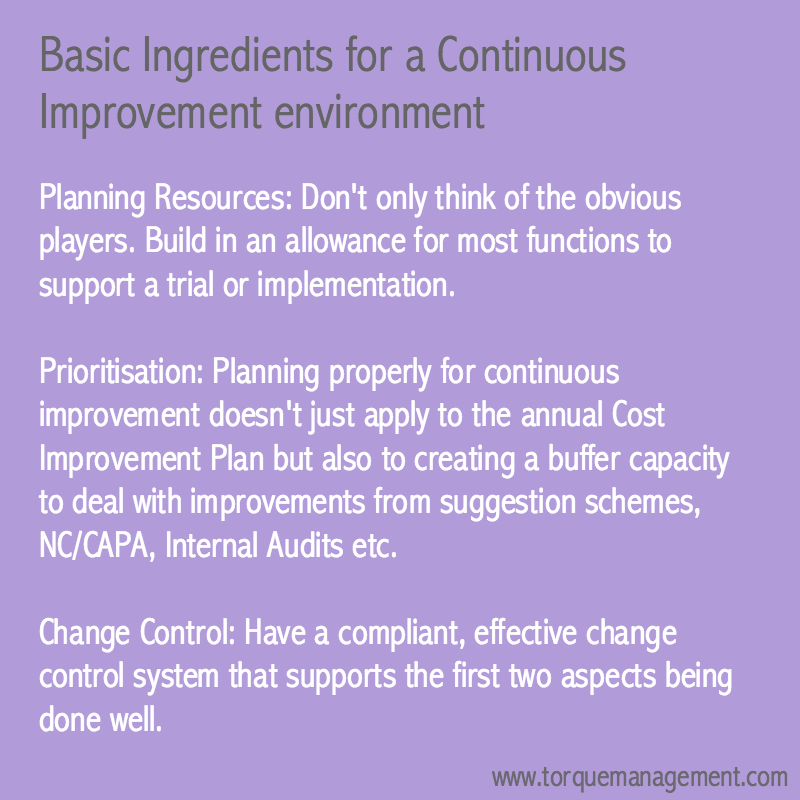Brian Cooney has a BA in management, is an ISO leader and recently completed an executive coaching diploma. Along with 33 years experience in quality assurance, he's an excellent example of someone with a vision for how well things can be done and the insight to recognise and successfully clear the hurdles that can get in the way.

1. You mention on your website that an organisation needs to be business and regulator focussed, and you approach organisation design for compliance and cost effective efficiency with that in mind. Do you see companies often focussed more on one than the other? And have you worked with anyone who's doing a good job of keeping both in mind equally? If so, maybe you'd tell us a little about the benefits they've seen?
I think companies are getting better at this and are demanding a broader business focus from their Quality function. The approach of Quality setting the rules and policing them as their only contribution to the organisation will not survive in the competitive industry environment of today. Therefore Quality as a function has had to broaden its perspective on the service they provide to organisations.
Initially, it may seem that you cannot represent the business and the regulator, nothing could be further from the truth. Compliance will only work consistently if all of the business is on board and you will only get this if the quality system supports doing the job in the most effective manner, right first time, every time. To do this you have to design a quality system that dovetails with the dynamic of the manufacturing process and drives RFT performance, builds predictability and quality in at all stages and affords early warning systems when things start to go wrong.
There are multiple business benefits ranging from obvious areas such as better yield performance, quick and early problem resolution, consistent product quality, to more cultural aspects such as good training, standardised approaches and predictable performance. All of this of course supports the most important aspect of all, customer satisfaction.

2. You also mention wanting to “unlock staff potential”. Is this a common problem and how have you seen it manifesting itself or how might a company spot it?
For big organisations I would not say that this is a common problem but having said that, it is not an easy aspect to do well. Most organisations have good programmes in place for this but in a lot of cases, business pressures dilute the potential benefit. By this I mean aspects such as training budgets, flexibility to move within the organisation and resources for backfill positions are all factors. One of the key challenges in my experience is that people are too busy to spend time on their development; this is becoming more and more prevalent as organisations try to do more with less.
Some of the symptoms to look out for are staff turnover, persistent performance at a “meets expectation” level for key staff where you would expect them to push the boundaries. On a day to day basis, a good manager will know the staff members that require more of their time and attention. On the positive side, people will emerge who are looking for greater responsibility, these are usually your go-to people who always seem to get the job done well.
Coaching can be of particular benefit in this area as it is designed to unlock the employees’ potential to solve their own problems and to facilitate that journey with them. This process encourages employees to be more responsible for their own growth and development, makes them more self-aware and lays the groundwork for more accurate and targeted learning and development plans.
3. And you note that the success of any system relies on the performance of the people who run it. Reading that it seems to make perfect sense but it doesn't seem like something companies work to on a day to day basis. Is this something you're seeing improvements in over the years?
As per the previous topic, most companies have on paper, a good performance management system but unfortunately usually leave performance management to the once/twice yearly formal sessions driven by these systems. I do think we are getting better at using these systems in this manner and are becoming more thorough and honest in performance appraisals. Where we still need to improve is in day to day performance management, both for positive and negative exemplars. We, especially in the Quality world are adept at analysing the technical situational aspects of problems but often fail to take advantage of timely learning opportunities with individuals where there has been poor performance. Likewise, we don’t re-enforce good performance enough with the classic but effective “well done and thank you”.
4. One of the things you do is design quality systems that support compliance, productivity and perhaps most interestingly, a 'Right First Time Culture'. If an organisation isn't getting it 'Right First Time', what are the knock-on effects of that?
If an organisation is not getting it right first time, there are obvious and significant business penalties associated with rework, scrap, extra testing, investigation time, customer dis-satisfaction etc. There are also cultural aspects to not doing it right first time. If the culture of a company is not a right first time one, then that implies that at some level, poor quality output is acceptable and that someone else is ultimately responsible for the final quality. If this is the environment, quality will never be everybody’s responsibility and the organisation will get un-predictable performance, higher than necessary cost of quality and probably poor compliance performance.
On the flip side, a right first time culture will drive the development of well-defined and effective procedures and systems designed to deliver consistent quality performance and embed responsibility throughout.

5. If a company is struggling with issues related to not having gotten it right any time, where is a good place for them to start in making efforts to change that culture? It seems like it could be a huge or nearly impossible task?
The first important step is for the senior management to commit to fixing the issue, they have got to believe and support the change. As regards implementation, I would advise a tactical approach based on data. The organisation should choose a specific area to pilot the new approach, for example, the biggest source of recurring non-conformance or the biggest source of recurring rework. The next step is to complete an in-depth root cause analysis that identifies the technical, management and performance factors contributing to the issue in order to identify the changes required to the modus operandi of the area. It is important that all aspects of root cause are considered so as to ensure the new modus operandi is successful. For example, if you put a new system in place that does not align with the daily business metrics, then the system will be managed to the daily metrics not the new approach. This analysis should include contributions from all affected parties, all too often it is restricted to management and professional input and therefore a lot of the detail of what actually happens on the shop floor is missed.
6. QMC also offers services for companies facing internal audits for ISO 9000/ ISO 13485 /FDA Part 820. What are some of the typical problems that arise when a company is undergoing an audit?
There are two perspectives here, firstly internal audits and secondly external ones.
From an internal audit perspective, the biggest failing I have seen is considering the internal audit process as a necessary evil rather than an opportunity for improvement. The great benefit of the internal audit is that it can be designed to give an organisation in-depth data on their quality system with a view to continuous improvement. To make this process work well, it needs top management support and sufficient time/resource allocated to it. The primary ingredient is to use trained auditors who are independent of the process being audited, ideally these auditors would come from other functions as well as QA. In my experience, the best internal audits are managed like an external one, where you set up the audit room, war room, expect auditees to give priority to the audit etc. One of the big watch-outs for internal audits is citing lots of minor items; this practice just clogs up the CAPA system and undermines the value of the audits. You can note minor issues for immediate correction but you should really focus on issues whose resolution will really drive improvement. The only caveat to this is where numerous minor issues indicate a system failing.
From an external audit perspective, the problems usually arise in preparation and audit management. There can be a tendency to spend all of the prep time, reviewing all SOPs, all training records, all calibration records etc. Whereas there is definitely benefit in doing a sample check in these areas, the organisation really needs to review areas such as Non-Conformance, CAPA, Validation, Complaints, Design Control to ensure that there is nothing in these areas that would call the safety and efficacy of the product into question. Also, the ongoing performance of these areas is paramount, so if you have multiple overdue CAPAs, Complaints etc., this is a big risk area
Good audit management during the audit is vital. All of the basics around a comfortable audit room, a well-managed “war-room”, document retrievers etc. are key to success. One of the most important aspects I believe is to set a good co-operative environment in the audit room, being adversarial never works. In fact, I would advise that one person, usually the QA Manager, should be primarily responsible to ensure that the audit room runs smoothly. Also, if during preparation, you allow senior management see the audit as solely a QA activity then you are not preparing properly. All functions of the site need to be involved in preparation, be available during audit week and be vigilant for the compliance of their people and the condition of their area while the audit is on. It is important that regular communication is given on how the audit is progressing.
7. Could you tell us what a continuous improvement environment is and the benefits of achieving that in a workplace?
I think the realities of business pressure almost naturally mandate a continuous improvement environment in most organisations; I have yet to come across an organisation that is happy with the status quo. Having said that, it is not easy to continuously improve performance and run the day to day business; especially in a regulated industry. From my experience, there are a few basics required:
Resources: When planning resources it is important to not just think of the obvious players such as engineers, as the drivers of continuous improvement. There should be some scope in most functions to spend time on developing opportunities. There also has to be allowance in most functions to support the trial and implementation of continuous improvement. So for example, if an engineer wants to try a new gadget on a manufacturing line, they will need operations and quality support at a minimum.
Prioritisation: It is vital to plan properly for continuous improvement; this does not apply just to the annual Cost Improvement Plan but also to creating a buffer capacity to deal with improvements from suggestion schemes, NC/CAPA, Internal Audits etc. Organisations need a forum that is senior enough and transparent to call priorities on improvement proposals. Nothing will kill a continuous improvement environment quicker than starting so many projects that none of them get finished properly and/or soliciting ideas and leaving them sit in limbo.
Change Control: It is vital to have a compliant and effective change control system that supports the first two aspects being done well. One of the key success factors, (assuming resourcing and prioritisation are done well) is ownership. If change control is not run as a collaborative exercise between the change owner and QA, then it will be treated as a bureaucratic burden to be worked around. Nothing creates more tension between QA and the organisation than a poorly designed and managed change control system.
8. As an Irish person with experience of working in a global quality role, what challenges and opportunities do you see for Ireland in this domain?
From a technology, business acumen and willingness to work hard perspective, we are there with the best of them. We also have a very rounded and mature international view of the business world. I think the new generation of professionals in Ireland are exceptionally well-qualified, very astute about aspects such as career management and are also very mobile globally. If you think about the broad spectrum of activity in Ireland ranging from agriculture/food to pharma/medical devices to information technology to services; this has created a new generation of ambitious and very well qualified professionals, so the future is bright.
www.qmc.ie